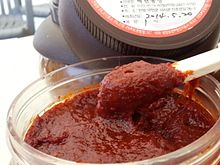Red pepper paste
 |
|
| Alternative names | Red chili paste |
|---|---|
| Place of origin | Korea |
| Main ingredients | Chili powder, glutinous rice, meju powder |
| Other information | HS code: 2103.90.1030 |
| |
|
| Korean name | |
| Hangul | 고추장 |
|---|---|
| Hanja | --醬 |
| Revised Romanization | gochu-jang |
| McCune–Reischauer | koch'u-chang |
| IPA | [ko.tɕʰu.dʑaŋ] |
Gochujang (/ˈkɔːtʃuːdʒæŋ/,from Korean: 고추장; gochu-jang [ko.tɕʰu.dʑaŋ]) or red chili paste is a savory, sweet, and spicy fermented condiment made from chili powder, glutinous rice, meju (fermented soybean) powder, yeotgireum (barley malt powder), and salt. The sweetness comes from the starch of cooked glutinous rice, cultured with saccharifying enzymes during the fermentation process. Traditionally, it has been naturally fermented over years in jangdok (earthenware) on an elevated stone platform, called jangdokdae, in the backyard.
In Sunchang County, North Jeolla Province, the Sunchang Gochujang Festival is held annually in Gochujang Village. In 2018, the Sunchang Gochujang Festival will take place in October.
It has commonly been assumed that spicy jang (장; 醬) varieties were made using black peppers and chopi, before the introduction of chili peppers. Shiyi xinjian, a mid-9th century Chinese document, recorded the Korean pepper paste as 椒醬 (lit. pepper paste). The second oldest documentation of pepper paste is found in the 1433 Korean book Collected Prescriptions of Native Korean Medicines. Pepper paste is again mentioned in a 1445 medical encyclopedia named Compendia of Medical Prescriptions.
...
Wikipedia
